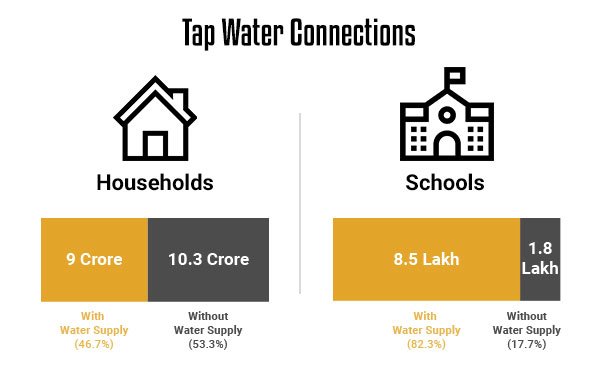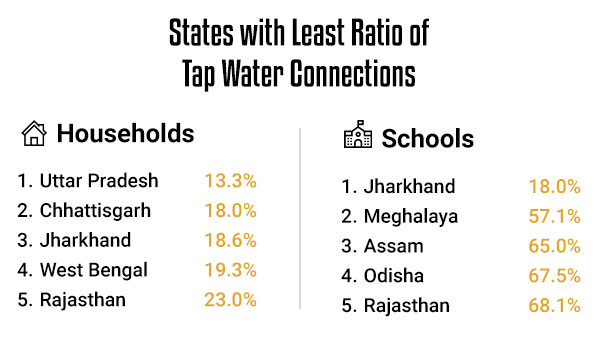
Lack of access to basic human needs such as clean water for all its citizens starkly contrasts with India’s growing ambitions to become a world superpower. It is estimated that 40 million Indians are affected by waterborne diseases every year, 1 lakh children under 5 die of diarrhea every year while the growth of many children is stunted due to consumption of polluted water. In addition to the human costs, the economic costs in terms of medical treatment and lost labor run into hundreds of millions.

Access to clean water has been a promise that has been made by many governments in India’s 75 years of independence. Beginning from the Accelerated Rural Water Supply Programme (ARWSP) launched in 1972-73 to the National Rural Drinking Water Programme in 2009, many programs have been launched. However, none of the programs achieved much progress, either due to lack of funds or lack of collaboration between the Centre and the states. In his Independence Day speech in 2019, PM Narendra Modi said that over half of the households in India did not have access to tap water connections at home. The statement, delivered from the ramparts of the Red Fort, brought the issue of water infrastructure back into the national limelight and set the stage for the start of the Jal Jeevan Mission.
Jal Jeevan Mission
The Jal Jeevan Mission (JJM) was launched in 2019 to ensure that every household in the rural villages has Functional Household Tap Connection (FHTC) by the year 2024 with an adequate quantity of 55 Liters per capita per day (LPCD) in prescribed quality. About 18,000 government engineers were commissioned which included hundreds of thousands of contractors and laborers laying more than 2.5 million miles of pipe.
An amount of Rs. 3.5 trillion was earmarked for the program, to be spent between 2019 to 2014. The amount was to be equally divided between the State and Central Government, except for the Himalayan and Northeastern states for which the Central government would bear 90% of the cost. Rs. 50,000 crore is estimated to have been spent on the program in 2021-22 and Rs. 60,000 crore is budgeted in 2022-23.

As of Feb 2022, the mission has succeeded in providing access to functional tap water to 5.8 lakh rural households and 4.1 lakh schools.

As of Feb 2022, 10.3 crore rural households (53.3%) do not yet have access to functional tap water while 1.8 lakh schools (17.7%) lack access to clean water through taps within their premises.

Not all states have equal access to clean water through taps. Only 13.3% of households in rural Uttar Pradesh and 18% in Chhattisgarh have access to clean tap water. The situation in schools is equally alarming in some states – only 18% of schools in Jharkhand have tap water connections in their premises.
Issues & Challenges
Some of the major issues and challenges in supplying clean tap water 24*7 to over 19 crore households are as below:
- Groundwater exploitation: Although India has 16% of the world’s population, it has only 4% of the world’s freshwater resource. India’s limited groundwater sources are fast depleting due to over-utilization, especially by farmers in areas prone to drought. India draws more groundwater than China and the US combined. This poses a serious challenge to the success of the JJM – while the pipes up to the households can be laid, there is not enough water to be provided through the pipelines.
- Center-state coordination: In India, water is a state subject. Ensuring 100% access to all households requires effective coordination between multiple entities at the Centre and the state, a point that has led to the failure of many earlier programs.
- Uneven distribution: Water is not properly distributed where it is supplied through pipes. Mega-cities like Delhi and Mumbai get more than the quantity compared to others.
- Water Quality: The groundwater distributed through pipes to households and schools contains contaminants such as fluoride and arsenic. To ensure monitoring of the water quality levels, five women in each village are being trained to test water samples by using Field test Kits (FTKs). However, this remains a voluntary exercise and is not always exercised.
- Intermittent electricity: Not all villages have sufficient and continuous electricity supply to operate the water pumps due to which there yet persists a culture of stocking up and storing water in buckets.
- Monthly Fee: The village bodies are expected to collect a monthly fee of approx. Rs 75 per household for maintenance of the pipelines and also to encourage a culture of participation and ownership. However, given the “freebie” and “water subsidy” culture promoted by politicians, very few members pay the monthly fee.
While the Jal Jeevan Mission aims to create an infrastructure for the provision of clean water to every household, issues such as groundwater exploitation remain a major bottleneck that will only further disturb the water-table balance in India.
TO READ THE FULL ARTICLE

Get full access to the exciting content on The Mirrority by logging in

Support independent journalism
Even the very best of media houses in our country today are yielding to the pressure of click-bait journalism in order to survive. More than ever before, our country needs journalism that is independent, fair and non-pliant to the bureaucracy. Such journalism needs the support of like-minded readers like you to help us survive editorially and financially.
Whether you live in India or India lives inside you, help us continue to produce quality journalism with your contribution.
CONTRIBUTE
